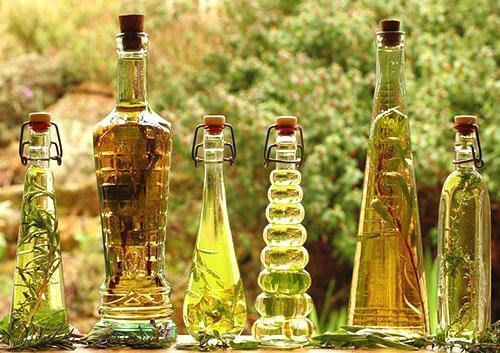The use of grape vinegar for culinary and medicinal purposes
 The story of the discovery of vinegar takes us back to the pre-biblical past of humanity. As an antiseptic and thirst quencher, it was known more than 7000 years ago. In ancient times, they paid attention to sour grape wine in a korchaga with a peculiar smell. The use of grape vinegar was found empirically. It was based on the practical use of a liquid as adding a few drops of sour wine to water for its purification and pleasant taste. Later, healers investigated the health of the newly obtained product.
The story of the discovery of vinegar takes us back to the pre-biblical past of humanity. As an antiseptic and thirst quencher, it was known more than 7000 years ago. In ancient times, they paid attention to sour grape wine in a korchaga with a peculiar smell. The use of grape vinegar was found empirically. It was based on the practical use of a liquid as adding a few drops of sour wine to water for its purification and pleasant taste. Later, healers investigated the health of the newly obtained product.
Read also the article: homemade grape wine!
Types of vinegars and methods of obtaining them

- white wine vinegar;
- red wine vinegar:
- balsamic vinegar;
- aromatic vinegar made from white wine vinegar.
Depending on the countries of origin, these products have their own national method of obtaining, their own wines, which means they have different aromas and tastes. White vinegar is the mildest of these categories. Fermentation takes place in a metal stainless container for a long time. Vinegar retains the delicate aroma of wine and is intended for dressing salads or for further flavoring.
 You can get white wine vinegar at home from varieties grown at their summer cottage grapes... In this case, the process is carried out by heating the wine without boiling. When half remains in the container, it will become homemade vinegar. Vinegar is prepared from grape pulp. In this case, the process takes 90 days.
You can get white wine vinegar at home from varieties grown at their summer cottage grapes... In this case, the process is carried out by heating the wine without boiling. When half remains in the container, it will become homemade vinegar. Vinegar is prepared from grape pulp. In this case, the process takes 90 days.
 Aromatization occurs by heating white wine vinegar to 40 degrees and placing aromatic spices in a vessel. The composition aged up to six months takes in not only the aroma, but is saturated with the useful components of the herb. Here, the imagination of the authors of the product is limited by his addiction to a particular scent.
Aromatization occurs by heating white wine vinegar to 40 degrees and placing aromatic spices in a vessel. The composition aged up to six months takes in not only the aroma, but is saturated with the useful components of the herb. Here, the imagination of the authors of the product is limited by his addiction to a particular scent.
Red vinegar is obtained from Cabernet-type wines by aging in an oak barrel. Naturally, the grape vinegars obtained in this way are expensive products, are used drop by drop, and are collected. But a special place is occupied by balsamic vinegar. The method of its production involves fermentation in a barrel for up to 12 years (see. Azerbaijani dolma in grape leaves - recipe).
 As a result, from 100 liters of wine, 15 liters of a product of a dark color and a very thick consistency are obtained. The taste of the resulting product is sweet and sour. They add it to ready-made meat and fish dishes, season salads. Balsamic, vinegar is named because it was originally used to treat wounds and their early healing.
As a result, from 100 liters of wine, 15 liters of a product of a dark color and a very thick consistency are obtained. The taste of the resulting product is sweet and sour. They add it to ready-made meat and fish dishes, season salads. Balsamic, vinegar is named because it was originally used to treat wounds and their early healing.
Vinegar is considered natural if no color, sugar or preservatives are listed on the label. There should be some sediment at the bottom of the glass bottle. The acid content is in the range of 5-9%. The cost of the product is high.
The benefits and harms of grape vinegar
 The resulting vinegar is characterized not only by its antibacterial properties and its ability to heal wounds. The concentrated content of useful components harvested from grapes makes vinegar healing. It contains:
The resulting vinegar is characterized not only by its antibacterial properties and its ability to heal wounds. The concentrated content of useful components harvested from grapes makes vinegar healing. It contains:
- polyphenols;
- organic acids;
- trace elements;
- vitamins.
These substances collected in a healing product affect the human body.So, the substance phytoalexin stands in the way of the development of tumors, heart and blood diseases. Flavonoids help the body to cope with disease by strengthening the immune system. Balsamic vinegar will relieve gout attacks and delay aging.
Many of the beneficial substances present in balsamic vinegar are not resistant to heat treatment. Therefore, vinegar is used in cold dishes, and is brought in before serving.
 Traditionally, in the Mediterranean countries, grape vinegar is used for marinating kebabs, preparing meat and fish dishes. Low-calorie dressing by the way for those who monitor their weight. In addition to cooking, grape vinegar is used:
Traditionally, in the Mediterranean countries, grape vinegar is used for marinating kebabs, preparing meat and fish dishes. Low-calorie dressing by the way for those who monitor their weight. In addition to cooking, grape vinegar is used:
- for medical purposes;
- in cosmetology.
The antibacterial properties of the product extend not only to skin disinfection and water disinfection. In case of internal poisoning or bacteriosis of the body, water with vinegar suppresses pathogenic microbes inside the body. Lotions using wine vinegar remove varicose veins on the legs. It is used as a fat burner for weight loss.
 One of the indicators of a lack of potassium in the body is coarsening of the skin, especially on the feet, appearing calluses and cracks. Namely, a high potassium content will help to cope with the problem if compresses with grape vinegar are applied to the affected areas.
One of the indicators of a lack of potassium in the body is coarsening of the skin, especially on the feet, appearing calluses and cracks. Namely, a high potassium content will help to cope with the problem if compresses with grape vinegar are applied to the affected areas.
Not only benefits, but also harm from grape vinegar can be obtained if used without taking into account the characteristics of the body. Contraindications for the use of the product include:
- childhood allergy to red grapes;
- diseases of the digestive system in the acute stage;
- inflammatory processes in the genitourinary system.
Grape vinegar is not combined with fermented milk products, vegetable proteins and potatoes.